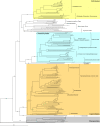High diversity and morphological convergence among melanised fungi from rock formations in the Central Mountain System of Spain
- PMID: 20396580
- PMCID: PMC2846131
- DOI: 10.3767/003158508X371379
High diversity and morphological convergence among melanised fungi from rock formations in the Central Mountain System of Spain
Abstract
Melanised fungi were isolated from rock surfaces in the Central Mountain System of Spain. Two hundred sixty six isolates were recovered from four geologically and topographically distinct sites. Microsatellite-primed PCR techniques were used to group isolates into genotypes assumed to represent species. One hundred and sixty three genotypes were characterised from the four sites. Only five genotypes were common to two or more sites. Morphological and molecular data were used to characterise and identify representative strains, but morphology rarely provided a definitive identification due to the scarce differentiation of the fungal structures or the apparent novelty of the isolates. Vegetative states of fungi prevailed in culture and in many cases could not be reliably distinguished without sequence data. Morphological characters that were widespread among the isolates included scarce micronematous conidial states, endoconidia, mycelia with dark olive-green or black hyphae, and mycelia with torulose, isodiametric or moniliform hyphae whose cells develop one or more transverse and/or oblique septa. In many of the strains, mature hyphae disarticulated, suggesting asexual reproduction by a thallic micronematous conidiogenesis or by simple fragmentation. Sequencing of the internal transcribed spacers (ITS1, ITS2) and 5.8S rDNA gene were employed to investigate the phylogenetic affinities of the isolates. According to ITS sequence alignments, the majority of the isolates could be grouped among four main orders of Pezizomycotina: Pleosporales, Dothideales, Capnodiales, and Chaetothyriales. Ubiquitous known soil and epiphytic fungi species were generally absent from the rock surfaces. In part, the mycota of the rock surfaces shared similar elements with melanised fungi from plant surfaces and fungi described from rock formations in Europe and Antarctica. The possibility that some of the fungi were lichen mycobionts or lichen parasites could not be ruled out.
Keywords: Capnodiales; Chaetothyriales; Dothideomycetes; biodiversity; black fungi; extremotolerance.
Figures






Similar articles
-
Phylogeny of rock-inhabiting fungi related to Dothideomycetes.Stud Mycol. 2009;64:123-133S7. doi: 10.3114/sim.2009.64.06. Stud Mycol. 2009. PMID: 20169026 Free PMC article.
-
Microcolonial fungi from antique marbles in Perge/Side/Termessos (Antalya/Turkey).Antonie Van Leeuwenhoek. 2007 Apr;91(3):217-27. doi: 10.1007/s10482-006-9111-9. Epub 2006 Nov 2. Antonie Van Leeuwenhoek. 2007. PMID: 17080290
-
Insights into fungal diversity of a shallow-water hydrothermal vent field at Kueishan Island, Taiwan by culture-based and metabarcoding analyses.PLoS One. 2019 Dec 30;14(12):e0226616. doi: 10.1371/journal.pone.0226616. eCollection 2019. PLoS One. 2019. PMID: 31887170 Free PMC article.
-
Identification of endophytic fungi from Livistona chinensis based on morphology and rDNA sequences.New Phytol. 2000 Sep;147(3):617-630. doi: 10.1046/j.1469-8137.2000.00716.x. New Phytol. 2000. PMID: 33862946 Review.
-
Fungal Diversity in Lichens: From Extremotolerance to Interactions with Algae.Life (Basel). 2018 May 22;8(2):15. doi: 10.3390/life8020015. Life (Basel). 2018. PMID: 29789469 Free PMC article. Review.
Cited by
-
Black fungi in lichens from seasonally arid habitats.Stud Mycol. 2008;61:83-90. doi: 10.3114/sim.2008.61.08. Stud Mycol. 2008. PMID: 19287530 Free PMC article.
-
Cellular responses of microcolonial rock fungi to long-term desiccation and subsequent rehydration.Stud Mycol. 2008;61:91-7. doi: 10.3114/sim.2008.61.09. Stud Mycol. 2008. PMID: 19287531 Free PMC article.
-
Bioweathering Potential of Cultivable Fungi Associated with Semi-Arid Surface Microhabitats of Mayan Buildings.Front Microbiol. 2016 Feb 23;7:201. doi: 10.3389/fmicb.2016.00201. eCollection 2016. Front Microbiol. 2016. PMID: 26941725 Free PMC article.
-
Arthrocatenales, a new order of extremophilic fungi in the Dothideomycetes.MycoKeys. 2024 Aug 22;108:47-74. doi: 10.3897/mycokeys.108.128033. eCollection 2024. MycoKeys. 2024. PMID: 39220356 Free PMC article.
-
Phylogeny of rock-inhabiting fungi related to Dothideomycetes.Stud Mycol. 2009;64:123-133S7. doi: 10.3114/sim.2009.64.06. Stud Mycol. 2009. PMID: 20169026 Free PMC article.
References
-
- Alves A, Crous PW, Correia A, Phillips AJL. 2008. Morphological and molecular data reveal cryptic speciation in Lasiodiplodia theobromae. Fungal Diversity 28: 1 – 13
-
- Arnold AE, Maynard Z, Gilbert G, Coley PD, Kursar TA. 2000. Are tropical fungal endophytes hyperdiverse? Ecology Letters 3: 267 – 274
-
- Bellido Mulas F, Rodríguez Fernández LR. Mapa Geológico de España. Instituto Tecnológico Geominero de España; Buitrago de Lozoya, Madrid, Spain: 1991.
-
- Berbee ML, Carmean DA, Winka K. 2000. Ribosomal DNA and resolution of branching order among the Ascomycota: How many nucleotides are enough? Molecular Phylogenetics and Evolution 17: 337 – 344 - PubMed
-
- Bills GF, Christensen M, Powell M, Thorn G. 2004a. Saprobic soil fungi. In: Mueller GM, Bills GF, Foster MS. (eds), Biodiversity of fungi. Inventory and monitoring methods: 271–302 Elsevier Academic Press, Burlington, MA, USA:
LinkOut - more resources
Full Text Sources
